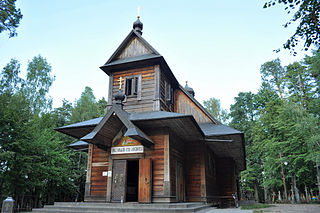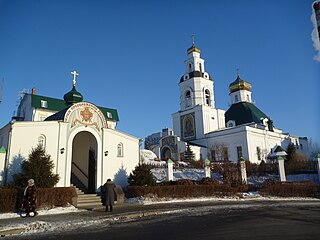
A crucifix is a cross with an image of Jesus on it, as distinct from a bare cross. The representation of Jesus himself on the cross is referred to in English as the corpus. The crucifix emphasizes Jesus' sacrifice, including his death by crucifixion, which Christians believe brought about the redemption of mankind. Most crucifixes portray Jesus on a Latin cross, rather than a Tau cross or a Coptic cross.

State atheism or atheist state is the incorporation of hard atheism or non-theism into political regimes. It is considered the opposite of theocracy and may also refer to large-scale secularization attempts by governments. To some extent, it is a religion-state relationship that is usually ideologically linked to irreligion and the promotion of irreligion or atheism. State atheism may refer to a government's promotion of anti-clericalism, which opposes religious institutional power and influence in all aspects of public and political life, including the involvement of religion in the everyday life of the citizen. In some instances, religious symbols and public practices that were once held by religions were replaced with secularized versions of them. State atheism in these cases is considered as not being politically neutral toward religion, and therefore it is often considered non-secular.

Our Mother of Perpetual Succour, colloquially known as Our Lady of Perpetual Help), is a Catholic title of the Blessed Virgin Mary associated with a 15th-century Byzantine icon and a purported Marian apparition. The image was enshrined in the Church of San Matteo in Via Merulana from 1499 to 1798 and is today permanently enshrined in the Church of Saint Alphonsus of Liguori in Rome, where the novena to Our Mother of Perpetual Help is prayed weekly.

The Catholic Church in Turkmenistan is part of the worldwide Catholic Church, under the spiritual leadership of the Pope in Rome.

The Minor Basilica of St. Lawrence the Deacon & Martyr is a minor basilica of the Roman Catholic Church in downtown Asheville, North Carolina, United States. The church was designed and built in 1905 by Spanish architect Rafael Guastavino along with his fellow architect R. S. Smith and the Roman Catholic community of Asheville. Pope John Paul II elevated the status of the church to minor basilica in 1993. It is a parish church, located within the Diocese of Charlotte. It is on the National Register of Historic Places and is the only basilica in western North Carolina. Its dome, inspired by the Basilica de los Desamparados of Valencia, has a span of 58 by 82 feet, and is reputed to be the largest, freestanding, elliptical dome in North America. The architectural style is Spanish Renaissance.

The Archcathedral Basilica of the Assumption of the Blessed Virgin Mary, usually called simply the Latin Cathedral is a 14th-century Latin Catholic cathedral in Lviv, western Ukraine. It is located in the city's Old Town, in the south western corner of the market square, called Cathedral Square.

Hoshiv is a village in the Ivano-Frankivsk Oblast of Ukraine, located about 4 km south east of Bolekhiv and 12 km north west of Dolyna, at around 49°1′30″N23°52′52″E. The village is known for its Basilian monastery which is a place of pilgrimage for the Ukrainian Catholic Church.

Transfiguration Cathedral is an Eastern Orthodox cathedral. It is located on Transfiguration Square, just off Liteyny Prospekt near the Chernyshevskaya metro station. Unlike most Russian churches, it has never ceased operating as a place of worship.
The Turkmen of Turkmenistan, are predominantly Muslims. According the U.S. Department of State's International Religious Freedom Report for 2022,
According to U.S. government estimates, the country is 93 percent Muslim, 6.4 percent Eastern Orthodox, and 0.6 percent other. There are small communities of Jehovah's Witnesses, Shia Muslims, Baha’is, Roman Catholics, the International Society for Krishna Consciousness, and evangelical Christians, including Baptists and Pentecostals. Most ethnic Russians and Armenians identify as Orthodox Christian and generally are members of the Russian Orthodox Church or Armenian Apostolic Church. Some ethnic Russians and Armenians are also members of smaller Protestant groups. There are small pockets of Shia Muslims, consisting largely of ethnic Iranians, Azeris, and Kurds, some located in Ashgabat, with others along the border with Iran and in the western city of Turkmenbashy.
The Holy See has long been recognised as a subject of international law and as an active participant in international relations. It is distinct from the city-state of the Vatican City, over which the Holy See has "full ownership, exclusive dominion, and sovereign authority and jurisdiction".

The Cathedral of the Transfiguration of the Lord is a Serbian Orthodox cathedral located on the Petar Preradović Square in Zagreb, Croatia. It was built in 1865–66 according to designs of architect Franjo Klein. It is ecclesiastically part of the Metropolitanate of Zagreb and Ljubljana and is known as the Zagreb Orthodox Cathedral. Due to 2020 Zagreb earthquake the Cathedral went to re-construction due to mayor damages that occurred.

The metropolitan city of Kraków, former capital of Poland, is known as the "city of churches". The abundance of landmark, historic Roman Catholic churches along with the plenitude of monasteries and convents earned the city a countrywide reputation as the "Northern Rome" in the past. The churches of Kraków comprise over 120 Roman Catholic places of worship, of which over 60 were built in the 20th century. They remain the centers of religious life for the local population and are attended regularly, while some are often crowded on Sundays.

The Metropolitan Cathedral of the Holy and Equal-to-the-Apostles Mary Magdalene is a Polish Orthodox cathedral, located at al. Solidarności 52 in Warsaw.

The Church of Sinai is a Greek Orthodox autonomous church whose territory consists of St. Catherine's Monastery at the foot of Mount Sinai in Egypt, along with several dependencies. There is a dispute as to whether the church is fully autocephalous or merely autonomous. The church is headed by the Archbishop of Mount Sinai and Raithu, who is traditionally consecrated by the Greek Orthodox Patriarch of Jerusalem and also serves as abbot for the monastery. The current hierarch is Archbishop Damian.

The Church of St. Louis of the French is a Roman Catholic church in Moscow, built 1790–91. It is located in the neighborhood of the Lubyanka, in the city center. The church was founded by and belongs to the French parish of the same name. One of the three operating Catholic churches in Moscow, along with the Cathedral of the Cathedral of the Immaculate Conception of the Holy Virgin Mary and the Church of St. Olga.

The Church of the Assumption of the Blessed Virgin Mary is a former Bernardine, now parish Catholic Church in Budslaw, Myadzyel District, Minsk Region, Belarus. The church is a monument of architecture of the late Baroque, and enshrines the icon of Our Lady of Budslau widely venerated in the country.

Paul Fitzpatrick Russell is an American prelate of the Catholic Church who was appointed auxiliary bishop of the Archdiocese of Detroit in May 2022. He previously served as the apostolic nuncio to Turkey, Turkmenistan, and Azerbaijan and the head of the diplomatic mission to Taiwan. In accordance with those roles, he has the personal title of archbishop.
An embassy chapel is a place of worship within a foreign mission. Historically, embassy chapels have sometimes acted as clandestine churches, tolerated by the authorities to operate discreetly. Since embassies are exempt from the host country's laws, which is a form of extraterritoriality, these chapels were able to provide services to prohibited and persecuted religious groups. For example, Catholic embassy chapels in Great Britain provided services while Catholicism was banned under the Penal Laws. A similar role was filled for Protestants by the Prussian embassy chapel in Rome, where Protestantism was unlawful until 1871. With the adoption of laws granting freedom of religion, these embassy chapels have often become regularized churches and parishes, such as that of the Dutch embassy chapel to the Ottoman Empire, now The Union Church of Istanbul.

Grabarka Holy Mount is a mount located next to the village of the same name in the Nurzec-Stacja Commune, Siemiatycze County, Podlaskie Voivodeship in eastern Poland. It is the most important place of religious worship for Orthodox believers in Poland. The complex includes nunnery of Saints Martha and Mary, established in 1947, as well as three monastery churches. The main monastery church, the Transfiguration of Jesus Christ Church is also a parish church. The monastery, Orthodox churches and two Pilgrim Houses make up the Grabarka-Klasztor settlement. There is also an Orthodox cemetery in the settlement. The complex has 9 ha.

The Church of the Transfiguration is one of the oldest Orthodox churches in Yekaterinburg, Russia. Construction work on the church took place from 1808 to 1830. During Soviet times, it was devastated and converted into a rubber goods factory. It was reclaimed by the faithful in 1995.
















